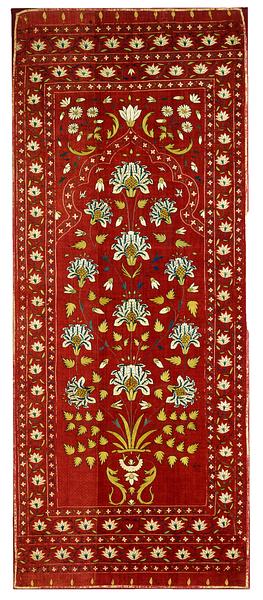Tent panel, cotton tabby, embroidered with silk
India; c. 1700
H: 175; W: 71 cm
This colorful red panel, which is a piece of quilted cotton fabric embroidered with silk, undoubtedly embellished one of the magnificent tents used by the Great Mughal and other Indian princes when they embarked on hunts, inspection tours, or campaigns.
The pattern, with a centrally placed, flowering plant, was much loved in India. Here it is quite stylized. The plant emerges from an almost abstract vase and the flowers’ species are not clearly defined. This depiction coincides with stylistic developments in around 1700, when art under the Great Mughal Aurangzeb returned to a more traditional Muslim, non-naturalistic depiction of reality.
Inv. no. 5/2005
Published in:
Robert Skelton (ed.): The Indian heritage: court life and arts under Mughal rule, Victoria and Albert Museum, London 1982, cat.no. 214;
Spink and Son: Islamic textile design: Islamic textiles amd their influence in Europe, London 1983, cat.no. 11;
Toby Falk (ed.): Treasures of Islam, Musée d’art et d’histoire, Geneve, London 1985, p. 335, cat.no. 348;
Sotheby’s, London, 12/10-2004, lot 10;
Leng Tan: Simon Ray: Indian and Islamic works of art, London 2005, cat.no. 62, pp. 142-145;
Sheila S. Blair and Jonathan M. Bloom (eds.): Cosmophilia. Islamic Art from the David Collection, Copenhagen, McMullen Museum of Art, Boston College, Boston 2006, cat.no. 67;
Kjeld von Folsach: Flora islamica: plantemotiver i islamisk kunst, Davids Samling, København 2013, cat.no. 65;
Steven Cohen: “Two outstanding Mughal qanat panels in the David Collection, with technical analyses and drawings of weaving structures by Anne-Marie Keblow Bernsted” in Journal of the David Collection, 4, 2014, p. 173, fig. 3;
